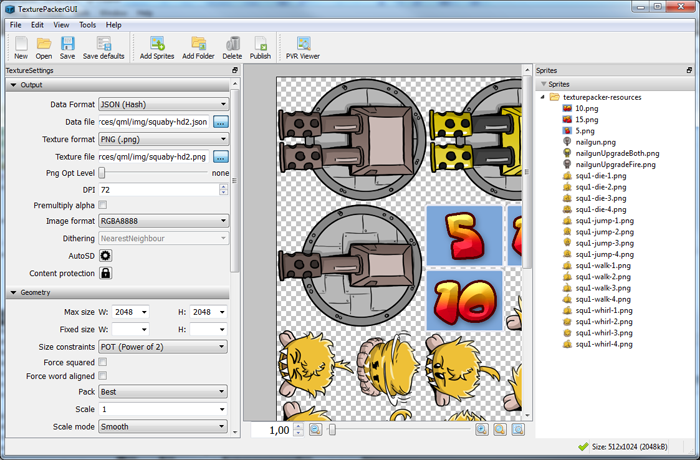

In order to ensure that the packing process does not lock your thread you will have to start the compilation process with pack.processAsync().then( success ).catch( error )

The Environment map should be handled separately. Default = true įor PBR materials you will need to change the map to reflect the channels you want to target. disposeSources:boolean, Toggle to dispose the source textures after they are packed.
#TEXTUREPACKER EXAMPLE UPDATE#
#TEXTUREPACKER EXAMPLE FULL#
fillBlanks:boolean, Toggle to full blank cell when a material does not use that channel. C (CSharp) TexturePacker Atlas - 3 examples found.paddingRatio:number, Ratio of the amount of padding to add to the frames.paddingColor:Color3|Color4, Custom color of the padding if paddingMode SUBUV_COLOR.paddingMode:number, Defines the padding style of the packer (SUBUV_WRAP, SUBUV_EXTEND, SUBUV_COLOR). Examples of outputting the foo directory following image through a configuration file BaseTextureSetting.tps created below TexturePacker GUI as a data file.frameSize:number, The base size of the frames before padding is added.colnum:number, If using LAYOUT_COLNUM will define the number of columns to use.layout:number, Defines the layout of the packer(LAYOUT_STRIP, LAYOUT_POWER2, LAYOUT_COLNUM).uvsOut:number, The target UV channel to modify on the targetMeshes.Let’s tell TexturePacker where to export the texture and data files. png) and the data file is a property list (.plist) with information about each sprite frame contained in the texture. The texture file is an image (for example, a. uvsIn:number, The target UV channel to use when creating the frames. Spritesheets are composed of a texture file and a data file.map:Array, An array that contains the names of the channels to pack on the materials if they exist.The options argument has a few parameters you can use to tweak the result of the texture packing. For example png optimization, jpg compression or image. Set the destination of your data and texture file. scene:Scene, The scene that everything is scoped to. Open TexturePacker, choose CSS as framework for your project and put in your sprites: Either drop your sprites.options:any, Basic object with argument parameters.targetMeshes:Array, Array of meshes to use as material sources.Pack.processAsync().then( success ).catch( error ) Create a TexturePacker by calling: let pack = new BABYLON.TexturePacker( name, targetMeshes, options, scene )


 0 kommentar(er)
0 kommentar(er)
